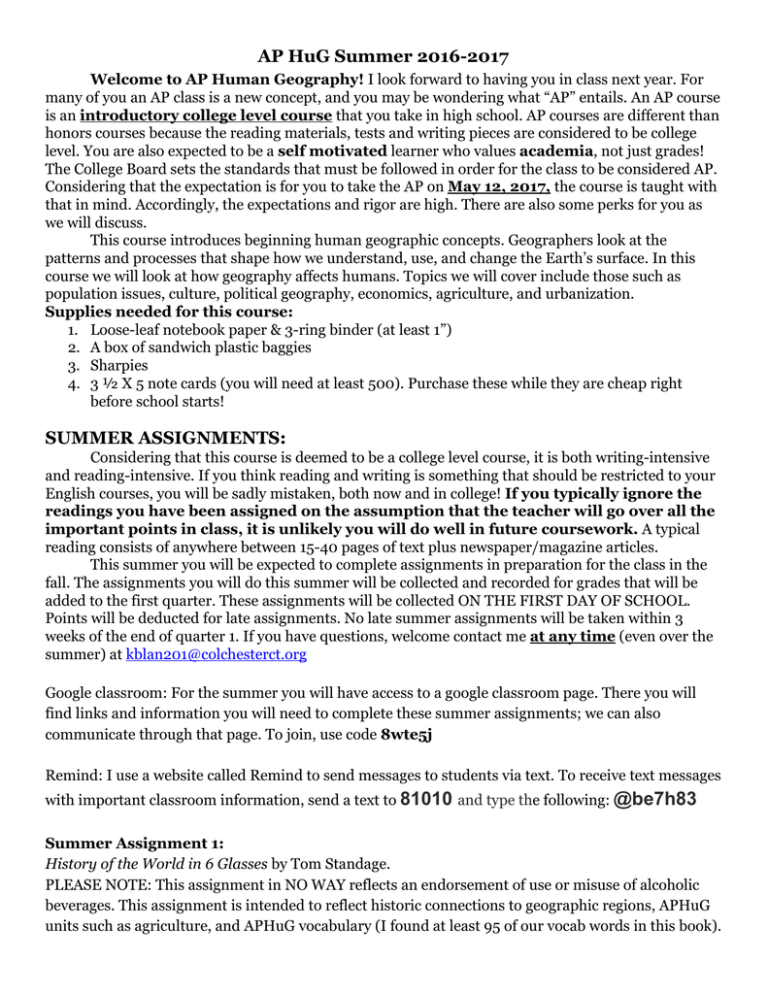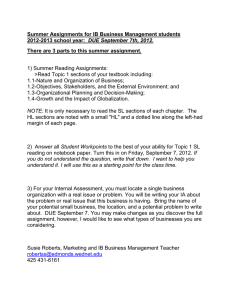AP HuG Summer 20162017 SUMMER ASSIGNMENTS:
advertisement

AP HuG Summer 2016­2017 Welcome to AP Human Geography! I look forward to having you in class next year. For many of you an AP class is a new concept, and you may be wondering what “AP” entails. An AP course is an introductory college level course that you take in high school. AP courses are different than honors courses because the reading materials, tests and writing pieces are considered to be college level. You are also expected to be a self motivated learner who values academia , not just grades! The College Board sets the standards that must be followed in order for the class to be considered AP. Considering that the expectation is for you to take the AP on May 12, 2017, the course is taught with that in mind. Accordingly, the expectations and rigor are high. There are also some perks for you as we will discuss. This course introduces beginning human geographic concepts. Geographers look at the patterns and processes that shape how we understand, use, and change the Earth’s surface. In this course we will look at how geography affects humans. Topics we will cover include those such as population issues, culture, political geography, economics, agriculture, and urbanization. Supplies needed for this course: 1. Loose­leaf notebook paper & 3­ring binder (at least 1”) 2. A box of sandwich plastic baggies 3. Sharpies 4. 3 ½ X 5 note cards (you will need at least 500). Purchase these while they are cheap right before school starts! SUMMER ASSIGNMENTS: Considering that this course is deemed to be a college level course, it is both writing­intensive and reading­intensive. If you think reading and writing is something that should be restricted to your English courses, you will be sadly mistaken, both now and in college! If you typically ignore the readings you have been assigned on the assumption that the teacher will go over all the important points in class, it is unlikely you will do well in future coursework. A typical reading consists of anywhere between 15­40 pages of text plus newspaper/magazine articles. This summer you will be expected to complete assignments in preparation for the class in the fall. The assignments you will do this summer will be collected and recorded for grades that will be added to the first quarter. These assignments will be collected ON THE FIRST DAY OF SCHOOL. Points will be deducted for late assignments. No late summer assignments will be taken within 3 weeks of the end of quarter 1. If you have questions, welcome contact me at any time (even over the summer) at kblan201@colchesterct.org Google classroom: For the summer you will have access to a google classroom page. There you will find links and information you will need to complete these summer assignments; we can also communicate through that page. To join, use code 8wte5j Remind: I use a website called Remind to send messages to students via text. To receive text messages with important classroom information, send a text to 81010 and type th e following: @be7h83 Summer Assignment 1: History of the World in 6 Glasses by Tom Standage. PLEASE NOTE: This assignment in NO WAY reflects an endorsement of use or misuse of alcoholic beverages. This assignment is intended to reflect historic connections to geographic regions, APHuG units such as agriculture, and APHuG vocabulary (I found at least 95 of our vocab words in this book). 1. Illustrated notebook entries ­ For each of the 6 different types of drinks address the following themes: A. Food, nutrition and culture B. Social class and political influence C. Medicine D. Currency/commodity/economics E. The drink as a catalyst for change Divide the notebook into 6 sections, one for each drink. As you read, write/cartoon/collage/illustrate/quote about what you learned based upon the themes outlined above. Your notebook entries should be neat, creative,reflective and informative (see some examples of journaling scrapbooks online). Your entries should reflect what you learned about history, world trade, geography, resources and cultural relativity. I found approximately 95 vocabulary words that fit our unit. Can you identify some of them? See if you can include some of the vocabulary that you think would fit AP Human Geography within the context of your notebook entries. 2. Mapping Geographic locations such as regions, cities and physical features play an important role in this book. As you create your illustrated notebook, be sure to include labeled maps. Begin with blank outline maps so that you can feature the important locations for each of the drinks. Blank outline maps are widely available on the internet. Here is a good place to start: www.worldatlas.com Summer Assignment 2: Take notes on the first chapter of the Barron’s text. This begins on page 58 and ends on page 85. Use a Cornell notes system. See the following website for information regarding Cornell notes. https://shp.utmb.edu/asa/Forms/cornell%20note%20taking%20system.pdf *****Readings for the summer assignments will be available on the Google classroom page Summer APHG 2016 listed above. Be sure to join ­ no need to purchase anything!


